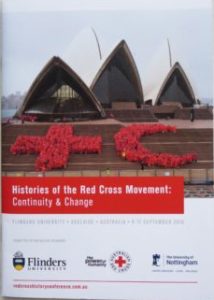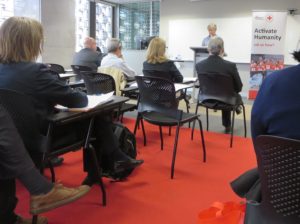by Sarah Glassford
This series is being reposted in HistPhil
During the weekend of 9-11 September 2016, roughly 50 scholars, archivists, museum curators, and aid practitioners gathered at Flinders University in Adelaide, Australia to discuss the oldest and arguably most complex of the world’s major humanitarian organizations. “Histories of the Red Cross Movement: Continuity & Change” brought together representatives of more than a dozen countries in Europe, Asia, North America, and Australasia in lively discussions of Red Cross history, Red Cross archives, and the nature of humanitarianism itself. This is the first in a series of blog posts reporting and reflecting on the issues raised at the conference.
“Histories of the Red Cross Movement: Continuity & Change” drew together three thought-provoking keynote speakers from different parts of the globe: American political scientist Michael Barnett (University Professor of International Affairs and Political Science at The George Washington University’s Elliott School of International Affairs, Washington, DC), European historian Davide Rodogno (Professor and Head of the International History Department at the Graduate Institute of International Studies, Geneva), and New Zealander historian Margaret Tennant (Professor Emeritus and Honorary Research Fellow at Massey University, Palmerston North). Each took a particular approach to thinking about the nature of humanitarianism and its history, but collectively their remarks paint a picture of a research field coming into its own.
Barnett began the collective conversation by asking “Is the ICRC[1] a Humanitarian or Human Rights Organization?” Explaining that the two approaches have traditionally been differentiated by who worked for each, where they worked, and how they talked about their work and its goals, he went on to note that recent decades have seen humanitarian and human rights organizations encroach on one another’s turf, provoking an identity crisis within the ranks of the former. Barnett laid out a lengthy list of elements that he believes still (or newly) distinguish the two, such as the difference between “needs” and “rights,” or their organizations’ respective toolkits for action. After assessing where the ICRC of today sits in each category of difference, Barnett concluded that the ICRC remains primarily a humanitarian organization – albeit one for which the human rights outlined in International Humanitarian Law play an important role.[2]
The following day, Rodogno pushed conference-goers to consider humanitarianism from a new angle, provocatively titling his remarks “The Ingrained Arrogance of Humanitarianism.” He described Western humanitarianism as “evasive and pervasive” in its many forms (ie. as an ethos, a moral imperative, an ideology, a form of governance, a movement, or an action), but argued that one consistent component of humanitarian motivation from the 18th century to the present is a kind of “arrogance.” Tracing the word back to its Latin roots, Rodogno defined arrogance in a humanitarian context as a complete certainty in one’s ability to help, and a resulting assumption of responsibility on others’ behalf. Humanitarians with doubts about their ability or ultimate success, he argued, either quelled those doubts or went home: a lack of certainty (arrogance) would undermine their whole operation. The lively discussion that followed raised questions such as how this arrogance may or may not hold true for modern self-critical humanitarians such as many of those within Médecins sans frontières? Rodogno speculated that if these individuals maintain their doubts and still work, this will change the profession and how humanitarian organizations operate overall.[3]
On day three, Tennant used the New Zealand Red Cross as a case study in relationships among “Sister Societies in the Red Cross Family,” and between these national organizations and their respective governments. Coming at the end of the conference, when attendees had heard about a variety of national Red Cross societies in the regular panels, Tennant’s New Zealand example served as a compelling reinforcement of the fact that despite many links and commonalities between national societies, both time and place have played indelible roles in shaping their respective work and successes (or failures). She argued particularly for the significance of a society’s relationship with its government – and the make-or-break ability of the state to delegate or rescind responsibility for areas like health, social welfare, or disaster relief.[4]
Although the keynote speakers focused on very different subjects, all three reflected back, in some measure, on the emergence of humanitarian history as a distinct sub-field of historical research. Barnett, for instance, whose Empire of Humanity[5] was one of the first books to attempt a grand synthesis of humanitarian history, mentioned in passing that when he “stumbled into” the subject 15 years earlier, it was not a field at all, merely a handful of sociologists, political scientists, and practitioners, toiling in obscurity. By contrast, he noted, as of 2016 it was both a thriving and an interdisciplinary field.[6]
Rodogno upheld this assessment, and outlined seven criteria he considered humanitarianism to fulfill as an area of historical inquiry. These included: rich and diverse approaches; consideration of many actors, and of the visions and discourses of those actors; attention to the agency of aid recipients; analysis of both intended and unintended consequences; and concern with a broad range of humanitarian spaces. He cautioned, however, against allowing this development to turn into overspecialization. Studying humanitarianism in isolation from its ties to empire, war, politics, economy, gender, and the like would be to miss the point entirely. The interdisciplinarity of the field, according to Rodogno, is its strength.[7]
 Tennant acknowledged the significance of the transnational currents and forces identified by Rodogno within a Red Cross movement that operates “under, over, and across the nation-state,” but made a strong case in her plenary for the continued value of studying aid organizations like the Red Cross on a national level. Even as historians of humanitarianism consider border-blurring wars and natural disasters, or theories of humanitarian motivation and action, she argued that they must not lose sight of the very different world of national efforts and local squabbles, because both the transnational and the local contribute to the whole.[8]
Tennant acknowledged the significance of the transnational currents and forces identified by Rodogno within a Red Cross movement that operates “under, over, and across the nation-state,” but made a strong case in her plenary for the continued value of studying aid organizations like the Red Cross on a national level. Even as historians of humanitarianism consider border-blurring wars and natural disasters, or theories of humanitarian motivation and action, she argued that they must not lose sight of the very different world of national efforts and local squabbles, because both the transnational and the local contribute to the whole.[8]
Taken together, the insights offered by Barnett, Rodogno, and Tennant suggest that historical inquiry around humanitarianism has reached a gratifyingly robust state in a relatively short period of time. They also offer diverse suggestions for future directions: from Rodogno’s caution against overspecialization and Tennant’s reminder of the continued importance of national contexts, to Barnett’s urging that scholars pay attention to the historical intertwining of legal issues with humanitarian ones. Guideposts such as these make it clear that the field will continue to develop and mature in coming years, as scholars plumb its depths and find new frameworks with which to make sense of what they find there.
——————
Dr. Sarah Glassford is a social historian of 20th century Canada, with an interest in the history of humanitarian aid. She is the author of Mobilizing Mercy: A History of the Canadian Red Cross (McGill-Queen’s University Press, 2017).
[1] ICRC = International Committee of the Red Cross
[2] Author’s notes from Michael Barnett, “Is the ICRC a Humanitarian or Human Rights Organisation?” plenary 1, “Histories of the Red Cross Movement: Continuity & Change,” Flinders University, Adelaide, Australia, 9 September 2016.
[3] Author’s notes from Davide Rodogno, “The Ingrained Arrogance of Humanitarianism,” plenary 2, “Histories of the Red Cross Movement: Continuity & Change,” Flinders University, Adelaide, Australia, 10 September 2016.
[4] Author’s notes from Margaret Tennant, “Sister Societies in the Red Cross Family,” plenary 3, “Histories of the Red Cross Movement: Continuity & Change,” Flinders University, Adelaide, Australia, 11 September 2016.
[5] Michael Barnett, Empire of Humanity: A History of Humanitarianism (Ithaca, NY: Cornell University Press, 2011).
[6] Author’s notes from Barnett, “Is the ICRC?”
[7] Author’s notes from Rodogno, “The Ingrained Arrogance.”
[8] Author’s notes from Tennant, “Sister Societies.”




